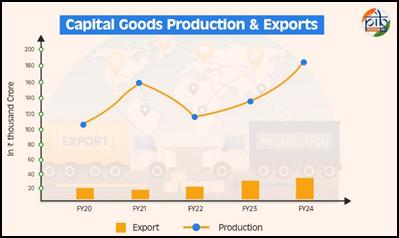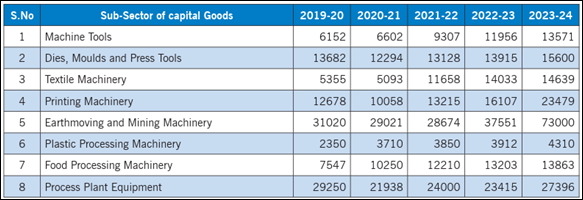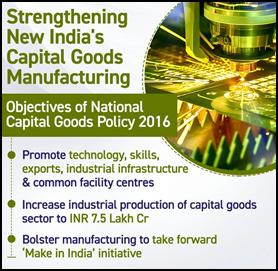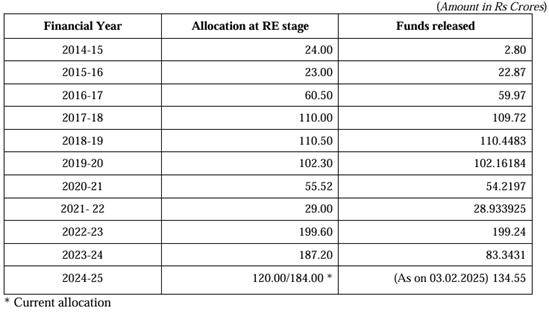Ministry of Commerce & Industry
Make in India and the Capital Goods Revolution
Catalyzing Domestic Production and Technological Innovation
Posted On:
02 APR 2025 6:52PM by PIB Delhi
Introduction
According to the Ministry of Heavy Industries, heavy engineering and machine tools sector comprises of capital goods industry. India's capital goods sector is experiencing significant attention due to its critical role in driving industrial growth and economic development. This sector encompasses industries such as electrical equipment, machinery, and construction, which are essential for the country's infrastructure development. According to the Indian Electrical and Electronics Manufacturers’ Association (IEEMA), the electrical equipment industry witnessed consistent double-digit growth in power equipment, particularly transmission equipment and transformers, driven by domestic demand and international market expansion.
India is the third-largest market for construction equipment. Government initiatives have been instrumental in bolstering the capital goods sector. The Ministry of Heavy Industries has launched several policies to boost domestic production and reduce reliance on imports. These initiatives are part of the broader Make in India campaign (launched in 2014), which seeks to increase the manufacturing sector's contribution to GDP, generate employment, and improve technological capabilities. The capital goods sector is crucial to India's economic strategy, supporting large-scale manufacturing and infrastructure projects. With rapid urbanization, extensive infrastructure development, and strong government support, the sector is poised to drive sustainable industrial growth and elevate India's position in the global market.
Overview of the Heavy Industries and Engineering Sector

As per the present estimates, the Capital Goods industry contributes about 1.9% of GDP. The Heavy Engineering and Machine Tool sector (capital goods industry) consists of the following major sub-sectors: Dies, Moulds and Press Tools; Plastic Machinery; Earthmoving and Mining Machinery; Metallurgical Machinery; Textile Machinery; Process Plant Equipment; Printing Machinery; and Food Processing Machinery. Due to catalytic effect of Ministry of Heavy Industries intervention, the production of capital goods sector has increased from Rs 2,29,533 crore in 2014-15 to Rs.4,29,001 crore in 2023-24. Production (in crores) by the sub-sectors of capital goods industry since 2019-20 are presented in the table below:

Exports (in crores) by the sub-sectors of capital goods industry since 2019-20 are presented in the table below:

The policy environment for the capital goods sector includes:
- No industrial license is required for the sector.
- FDI up to 100% permitted on automatic route (through RBI) except from the countries having land borders with India.
- Quantum of payment for technology transfer, design and drawing, royalty, etc. to the foreign collaborator is not restricted.
- There is no restriction on imports and exports.
The Union Budget 2025-26 proposes to add 35 additional capital goods for EV battery manufacturing, and 28 additional capital goods for mobile phone battery manufacturing to the list of exempted capital goods. This will boost domestic manufacture of lithium-ion battery, both for mobile phones and electric vehicles.
National Capital Goods Policy (2016)
The National Capital Goods Policy, formulated by the Ministry of Heavy Industries & Public Enterprises, is a comprehensive framework aims at boosting the capital goods sector in India. policy envisions increasing the sector's contribution to manufacturing activity from 12% (2016) to 20% by 2025. It seeks to make India one of the top capital goods producing nations, aiming to more than double production and increase exports to at least 40% of the total production. Furthermore, the policy aims to enhance the technology depth within the sector, moving from basic and intermediate levels to advanced levels.

The major salient features of the policy are:
- To increase budgetary allocation and scope of the Scheme on Enhancement of Competitiveness in the Capital Goods Sector adding components i.e. skills, capacity building, advanced manufacturing and cluster development.
- To launch a Technology Development Fund under PPP model to fund technology acquisition/ transfer, purchase of IPRs/ designs and drawings/ commercialization.
- To set up regional State-of-the-Art Greenfield Centre of Excellence for skill development.
- To modernize existing CG manufacturing units, especially SMEs by replacing with the modern, computer controlled and energy efficient machineries across capital goods sub-sectors.
- To upgrade/ develop, testing and certification infrastructure.
The National Capital Goods Policy, 2016, inter alia, recommended increasing the budgetary allocation and scope of the Scheme on Enhancement of Competitiveness of Capital Goods which included setting up of Centers of Excellence, Common Engineering Facility Centers, Integrated Industrial Infrastructure Park and Technology Acquisition Fund Programme. These recommendations were incorporated in the Phase II of the scheme.
Scheme for Enhancement of Competitiveness in the Indian Capital Goods Sector Phase I
In order to address the skill gaps, infrastructure development and technology needs for the capital goods sector, Phase I of the capital goods scheme was rolled out in November 2014 which had the total outlay of Rs 995.96 crores. Phase I of the scheme fostered partnerships between academia and industry for engendering technology development with government support. The outcome of the Scheme has proved the efficacy of the strategies deployed for technology and industrial infrastructure development.
- Centre of Excellence (CoE): 8 CoEs have been established wherein 30 niche indigenous technologies have been successfully developed in the fields of machine tools, additive manufacturing, textile machinery, welding robots and alloys design, earth moving machinery, and sensor technologies at national research institutes of eminence such as Indian Institute of Technology (IITs), Indian Institute of Sciences (IISc), Central Manufacturing Technology Institute (CMTI) etc.
- Common Engineering Facility Centres (CEFC) - 15 CEFCs including four Industry 4.0 SAMARTH centres and six Web-Based Technology Innovation Platforms (TIPs) have been setup. Industry 4.0 SAMARTH centres are at Indian Institute of Sciences at Bengaluru, Centre for Industry 4.0 (C4i4) lab at Pune, Central Manufacturing Technology Institute (CMTI) at Bengaluru and Indian Institute of Technology (IIT) Delhi.
- The six web-based open manufacturing technology innovation platforms are helping in bringing all India’s technical resources and the concerned Industry on to one platform to kick start and facilitate identification of technology problems faced by Indian Industry and crowd source solutions for the same in a systematic manner so as to facilitate start-ups and angel funding of India innovations.
- Over 76,000 students, experts, institutes, industries and labs have already registered on these platforms so far.
- Technology Acquisition Fund Programme (TAFP) – Following 5 technologies have been acquired from abroad under TAFP:
- Development & Commercialization of Titanium Casting with Ceramic Shelling Technology;
- Manufacturing of Heavy-Duty High Reliability Electrical Specialized Power Cables;
- Development of Turn Mill Centre;
- Development of Four Guideway CNC Lathe;
- Cutting Edge Robotic Laser Cladding Technology.
- Integrated Machine Tools Park, Tumakuru: An exclusive industrial park for machine tool industry has been developed across 530 acres at Tumkuru, Karnataka. So far, out of 336 acres of allottable land, 145 acres of land has been allotted to the machine tool manufacturers.
Under Phase- I of the Scheme for Enhancement of Competitiveness in the Indian Capital Goods Sector, 33 projects with budgetary support of Rs. 583.312 crore were sanctioned. After launching of the Capital Goods Scheme Phase II, The Phase I of the Capital Goods Scheme has been merged with Phase II of the Scheme.
Scheme for Enhancement of Competitiveness in the Indian Capital Goods Sector Phase II
Ministry of Heavy Industries notified the Phase 2 of the Scheme on January 25, 2022, with an objective to expand and enlarge the impact created by Phase I of the capital goods scheme, thereby providing greater impetus through creation of a strong and globally competitive capital goods sector. The scheme has a financial outlay of Rs. 1207 crores with budgetary support of Rs. 975 crore and industry contribution of Rs. 232 crores. Under the Phase II, a total of 33 projects with project cost of Rs 1366.94 crores (due to higher contribution by Industry) and government contribution of Rs 963.19 crore have been sanctioned by August 2024. There are six components under the Phase II and the details of the projects sanctioned so far are:
- Setting up of New Advanced Centres of Excellence and augmentation of Existing Centres of Excellence: To expedite R&D by utilizing academia of repute and private industry which is involved in research and development activities. A total of 9 projects with the budget of Rs. 478.87 have been sanctioned so far.
- Setting up of Common Engineering Facility Centres (CEFCs) and augmentation of existing CEFCs: For creating demonstration & training, consultancy, hand holding and R & D services and awareness programmes to industrial units. A total of 5 projects with the budget of Rs. 357.07 have been sanctioned so far.
- Promotion of skilling in Capital Goods Sector: Creation of Qualification packages for skill levels 6 and above- in association with Skill Councils for skills level 6 and above. A total of 3 projects with the budget of Rs. 7.59 have been sanctioned so far.
- Augmentation of Existing Testing and Certification Centres: To address the needs of Capital Goods Sector & Auto sector for testing of machinery in terms of various properties relating to mechanical, electrical, chemical, structural, metallurgical, electronics aspects etc. A total of 7 projects with the budget of Rs. 195.99 have been sanctioned so far.
- Setting up of Industry Accelerators for Technology Development: Aimed at development of targeted indigenous technologies, scaled to meet the requirements of selected industry segment, which till now has been dependent on imports. Selected Academic Institute/ Industry Body will act as an Accelerator for fostering the development of such technologies. A total of 8 projects with the budget of Rs. 325.32 have been sanctioned so far.
- Identification of Technologies through Technology Innovation Portals: Six Web-based open manufacturing technology innovation platforms have been developed under CG Scheme Phase-I. These are being supported under CG Scheme Phase-II.
The details of the funds allocated and its utilization under the Scheme for Enhancement of Competitiveness in the Indian Capital Goods Sector Phase- I and II is as given in the table below:

Recent Achievements of the Capital Goods Scheme
- Sitarc, Coimbatore has indigenously developed a 6-inch BLDC submersible pump with a motor efficiency of 88% and a pump efficiency of 78% under the Capital Goods Scheme. This initiative promotes "Aatmanirbharta" by reducing the import of such pumps by 80%. This innovation was recognized as the best product in the pumps category by United Nations Industrial Development Organization (UNIDO).
- CMTI has developed a high-speed rapier loom machine capable of weaving yarns upto 450 RPM. This machine was launched at ITMA 2023 in Milan, Italy.
- Under the SAMARTH centre at CMTI, Industrial Internet of Things (IIOT) technology has been implemented in Toyota Engine Manufacturing line controlling 64 machines for preventive maintenance.
- A testing facilities for battery and Battery Management System (BMS) has been established at ARAI, Pune for the first time in India under the aegis of Ministry of Heavy Industries.
- 6 Smart Technologies, 5 Smart Tools, 14 solutions have been developed in digital twin, virtual reality, robotics, inspection, sustainability, additive manufacturing etc. by I-4.0 India @ IISc, Bengaluru;
- Under Industry Accelerator at ARAI-Advanced Mobility Transformation & Innovation Foundation (AMTIF) a high-voltage motor controller developed, which enabled the industry partner Raptee Energy Private Limited to launch a high-voltage motorcycle with electric car DNA.
- Under Industry Accelerator at ARAI-Advanced Mobility Transformation & Innovation Foundation (AMTIF) thermally stable sodium-ion batteries developed.
Bharat Heavy Electricals Limited (BHEL)
BHEL is a major contributor towards engineering and manufacturing capacity building for the Country. The company is carrying out following initiatives with support from Ministry of Heavy industries under the Capital Goods Scheme Phase II:
• BHEL has established a “Common Engineering Facility Centre (CEFC)” for skill development in Welding Technology at WRI Trichy along with its extension centers at Varanasi, Ranipet, Bhopal, Jhansi and Haridwar units of BHEL.
• BHEL is establishing a testing facility comprising both Hardware in the Loop (HIL) and Software in the Loop (SIL) functionalities in the area of Industrial, Naval and Aircraft related processes at its Corporate R&D Unit at Hyderabad with support from Ministry of Heavy Industries.
Conclusion
The ‘Make in India’ initiative has had a transformative impact on the heavy industries and engineering sector. By fostering technological advancements, increasing domestic production, enhancing competitiveness, and generating employment, the initiative has played a pivotal role in strengthening India’s industrial base. With sustained policy support and continued investment, the sector is poised for further growth in the coming years.
References
https://www.investindia.gov.in/sector/capital-goods
https://pib.gov.in/PressReleseDetail.aspx?PRID=2098364
https://pib.gov.in/PressReleasePage.aspx?PRID=2085938
https://www.pib.gov.in/PressReleasePage.aspx?PRID=2042179
https://pib.gov.in/PressReleaseIframePage.aspx?PRID=2039020
https://www.indiabudget.gov.in/economicsurvey/doc/echapter.pdf
https://heavyindustries.gov.in/heavy-engineering-and-machine-tool
https://x.com/investindia/status/1302798627337723904?lang=ar-x-fm
https://heavyindustries.gov.in/sites/default/files/2023-07/Capital-Goods-Policy-Final.pdf
https://sansad.in/getFile/loksabhaquestions/annex/184/AU1227_CBVr5x.pdf?source=pqals
https://sansad.in/getFile/loksabhaquestions/annex/182/AU1375_e9YzYN.pdf?source=pqals
https://heavyindustries.gov.in/scheme-enhancement-competitiveness-indian-capital-goods-sector-phase-i
https://heavyindustries.gov.in/scheme-enhancement-competitiveness-indian-capital-goods-sector-phase-ii
https://heavyindustries.gov.in/sites/default/files/2025-02/heavy_annual_report_2024-25_final_27.02.2025_compressed.pdf
Make in India and the Capital Goods Revolution
****
Make in India (CG) | Explainer | 07
Santosh Kumar | Sheetal Angral | Rishita Aggarwal
(Release ID: 2117968)
Visitor Counter : 4691